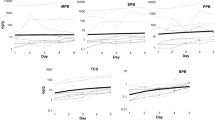Abstract
The objective of the project was to ascertain whether urinary biomarkers of permethrin exposure are detected after wearing post-tailored, fabric-treated military uniforms under two different wear-time exposure scenarios. Study A occurred over 3.5 days and involved six participants wearing treated uniforms continuously for 30–32 h. Urine collection occurred at scheduled time points before, during, and after wearing the uniform. Study B, conducted over 19 days, included 11 participants wearing treated uniforms for 3 consecutive days, 8 h each day (with urine collection before, during, and after wear). Urinary biomarkers of permethrin (3-phenoxybenzoic acid (3PBA), cis- 2,2-(dichlorovinyl)-2,2-dimethylcyclopropane-1-carboxylic acid (cDCCA), trans- 2,2-(dichlorovinyl)-2,2-dimethylcyclopropane-1-carboxylic acid (tDCCA)) were detected during and after wear. Biomarker detection generally occurred over the 10- to 12-h period after putting on the uniform and subsided 24 h following uniform removal (in both Study A and B scenarios). Those wearing permethrin-treated uniforms under the longer wear-time scenario (Study A) excreted significantly higher cumulative mean levels compared with those in Study B (3.29 times higher for 3PBA and 2.23 times higher for the sum of c/tDCCA (P≤0.001)). Findings suggest that wearing permethrin-treated clothing does increase absorbed, internal dose levels of permethrin above population levels and is significantly related to wear-time duration.
This is a preview of subscription content, access via your institution
Access options
Subscribe to this journal
Receive 6 print issues and online access
$259.00 per year
only $43.17 per issue
Buy this article
- Purchase on Springer Link
- Instant access to full article PDF
Prices may be subject to local taxes which are calculated during checkout



Similar content being viewed by others
References
Fricker RD, Reardon E, Spektor DM, Cotton SK, Hawes-Dawson J, Pace JE et al Pesticide Use During the Gulf War: A Survey of Gulf War Veterans. RAND Corporation: Santa Monica, CA, USA. 2000.
Appel KE, Gundert-Remy U, Fischer H, Faulde M, Mross KG, Letzel S et al. Risk assessment of Bundeswehr (German federal armed forces) permethrin-impregnated battle dress uniforms (BDU). Int J Hyg Environ Health 2008; 211: 88–104.
Naumann DN, Baird-Clarke CD, Ross DA . Fleas on operations in Afghanistan—environmental health measures on the front line. J R Army Med Corps 2011; 157: 226–228.
White DJ, Davis P, Walter MH . Survey of repellent use by service members arriving in Kuwait for Operation Iraqi Freedom 2. Mil Med 2005; 170: 496–500.
Macedo PA, Peterson RKD, Davis RS . Risk assessments for exposure of deployed military personnel to insecticides and personal protective measures used for disease-vector management. J Toxicol Environ Health A 2007; 70: 1758–1771.
United States Army All Army Activities (ALARACT) 289/2012, 16 OCT 12, Headquarters Department of Army, Subject: Factory Treated Army Combat Uniforms with Permethrin (ACU Permethrin) 2012.
Faulde MK, Uedelhoven WM, Malerius M, Robbins RG . Factory-based permethrin impregnation of uniforms: residual activity against Aedes aegypti and Ixodes ricinus in battle dress uniforms worn under field conditions, and cross-contamination during the laundering and storage process. Mil Med 2006a; 171: 472–477.
Rossbach B, Appel KE, Mross KG, Letzel S . Uptake of permethrin from impregnated clothing. Toxicol Lett 2010; 192: 50–55.
Faulde M, Uedelhoven W . A new clothing impregnation method for personal protection against ticks and biting insects. Int J Med Microbiol 2006b; 296 (Suppl 1): 225–229.
Faulde M, Scharninghausen J, Tisch M . Preventive effect of permethrin-impregnated clothing to Ixodes ricinus ticks and associated Borrelia burgdorferi s.l. in Germany. Int J Med Microbiol 2008; 298 (Suppl 1): 321–324.
Khoobdel M . Evaluation of permethrin treated clothing for personal protection against phlebotomus papatasi (diptera: psaychodidae). J Entomol 2008; 5: 51–55.
Khoobdel M, Shayeghi M, Vatandoost H, Rassi Y, Abaei MR, Ladonni H et al. Field evalutation of permethrin-treated military uniforms against anopheles stephensi and 4 species of culex (diptera: culicidae) in Iran. J Entomol 2006; 3: 108–118.
Ahn KC, Ma SJ, Tsai H-J, Gee SJ, Hammock BD . An immunoassay for a urinary metabolite as a biomarker of human exposure to the pyrethroid insecticide permethrin. Anal Bioanal Chem 2006; 384: 713–722.
Riederer AM, Bartell SM, Barr DB, Ryan PB . Diet and nondiet predictors of urinary 3-phenoxybenzoic acid in NHANES 1990-2002. Environ Health Perspect 2008; 116: 1015–1022.
Barr DB, Olsson AO, Wong L-Y, Udunka S, Baker SE, Whitehead RD et al. Urinary concentrations of metabolites of pyrethroid insecticides in the general U.S. population: National health and nutrition examination survey 1999–2002. [Research]. Environ Health Perspect 2010; 118: 742–748.
Vijverberg HP, van den Bercken J . Neurotoxicological effects and the mode of action of pyrethroid insecticides. Crit Rev Toxicol 1990; 21: 105–126.
National Research Council. Health Effects from Permethrin-impregnated Army Battle Dress Uniforms. National Academy Press: Washington, DC. 1994.
United States Environmental Protection Agency (USEPA) Memorandum: Permethrin: Updated Revised Occupational and Residential Exposure Assessment for the Reregistration Eligibility Decision Document. Found at http://www.npmapestworld.org/publicpolicy/documents/EPARiskAssessmentforPermethrin.pdf . Accessed on 29 April 2013 2005.
Baker SE, Olsson AO, Barr DB . Isotope dilution high-performance liquid chromatography-tandem mass spectrometry method for quantifying urinary metabolites of synthetic pyrethroid insecticides. Arch Environ Contam Toxicol 2004; 46: 281–288.
Olsson AO, Baker SE, Nguyen JV, Romanoff LC, Udunka SO, Walker RD et al. A liquid chromatography—tandem mass spectrometry multiresidue method for quantification of specific metabolites of organophosphorus pesticides, synthetic pyrethroids, selected herbicides, and deet in human urine. Anal Chem 2004; 76: 2453–2461.
Barr DB, Wilder LC, Caudill SP, Gonzalez AJ, Needham LL, Pirkle JL . Urinary creatinine concentrations in the U.S. population: implications for urinary biologic monitoring measurements. Environ Health Perspect 2005; 113: 192–200.
Center for Disease Control and Prevention (CDC) About BMI for Adults Found at http://www.cdc.gov/healthyweight/assessing/bmi/adult_bmi/index.html#Interpreted . Accessed on 29 April 2013.
Acknowledgements
We acknowledge the contribution of SFC Darnell Dobbins and Ms Nicole Longcore in the data collection and early data analyses stages of this project. We also greatly appreciate the experience and input from Melynda Perry (Textile Chemist, Natick Soldier Research, Development and Engineering Center Natick, MA) who also conducted the permethrin analyses of the uniforms. Moreover, we thank the Division of Laboratory Sciences, National Center for Environmental Health, Centers for Disease Control and Prevention for performing the pyrethroid metabolite analyses of the urine samples.
Author information
Authors and Affiliations
Corresponding author
Ethics declarations
Competing interests
The authors declare no conflict of interest.
Additional information
Disclaimer
The views expressed are those of the authors and do not reflect the official policy of the Department of the Army or the Department of Defense.
Rights and permissions
About this article
Cite this article
Proctor, S., Maule, A., Heaton, K. et al. Permethrin exposure from fabric-treated military uniforms under different wear-time scenarios. J Expo Sci Environ Epidemiol 24, 572–578 (2014). https://doi.org/10.1038/jes.2013.65
Received:
Revised:
Accepted:
Published:
Issue Date:
DOI: https://doi.org/10.1038/jes.2013.65
Keywords
This article is cited by
-
Individual-level permethrin exposure biomarkers in U.S. army soldiers: comparison of two treatment formulations for military uniforms
Journal of Exposure Science & Environmental Epidemiology (2023)
-
Permethrin-treated baby wraps for the prevention of malaria: results of a randomized controlled pilot study in rural Uganda
Malaria Journal (2022)
-
Permethrin exposure from wearing fabric-treated military uniforms in high heat conditions under varying wear-time scenarios
Journal of Exposure Science & Environmental Epidemiology (2020)
-
Bioabsorption and effectiveness of long-lasting permethrin-treated uniforms over three months among North Carolina outdoor workers
Parasites & Vectors (2019)



